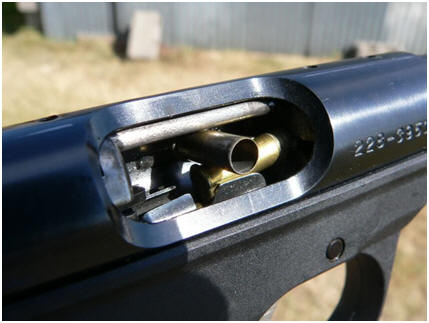There are three major categories of pistol malfunctions, numbered from one to three. These are important to know and understand in order to properly, safely, and quickly remedy the malfunction. Let’s walk through each category and review what should have happened, what did happen and how to get your pistol running properly again.
Ammunition Malfunctions – Failure to Fire
This one is probably the most common malfunction in today’s semi-automatic pistol world. The cycle of operation for most firearms is the same. Load, fire, extract, eject… repeat. The ammunition malfunction stops the gun before we even get started. What could have happened? There are three types of ammunition mishaps, each increasing in danger.
The first is the Misfire. I’ve seen this from time to time when shooters come to the range and perform the very same steps every time. With little or no deviation, they load their magazine, pick the gun up while it’s at slide-lock and load the magazine near bench height. They release the slide to load the top round from the magazine and begin to fire. When the slide locks open again, they remove the magazine, put the gun down and repeat. Over and over again, they practice loading their firearm at belly-button height and only loading by releasing the slide. If this type of shooter adds a magazine when the slide is not open, a round is not chambered. Up comes the pistol and silence. I’m always surprised at how perplexed these shooters look at this moment. In this case, we don’t really have a misfire or even a malfunction. The gun has not been loaded! The remedy in this situation is to simply rack the slide to chamber the first round. When using a revolver, the remedy is to pull the trigger again to rotate the cylinder to the next chamber.
A real malfunction often happens when the shooter is using poor ammo. I buy the cheapest Russian ammo I can find. It saves money and provides good practice for the failure to fire malfunction! In the cheaper ammo the primers are often too hard or just bad. The firing pin properly strikes the round but the primer fails to ignite the powder in the cartridge case. We hear click and silence. Failure to fire. But wait! There’s a safety concern in this case. Suppose the primer did star the powder in the case to burn, but it’s burning very slowly? This misfire could turn into a Hang Fire without any intervention on our part. Keep that barrel pointed downrange (Remember the second firearm safety rule? Keep the muzzle pointed in a safe direction at all times.) in case the round finally goes off. After 15 to 30 seconds, the remedy is to tap the magazine to ensure it’s properly seated and rack the slide, ejecting the bad round and chambering a new one. Again, with a revolver, just pull the trigger.
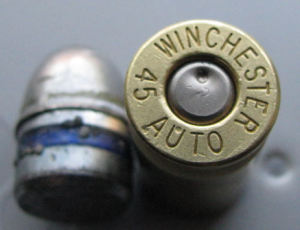 The most dangerous ammunition malfunction is the Squib Load. If you fire the handgun and you hear an almost inaudible “Pop” or soft “Poof” sound (rather than a loud bang) and/or feel or observe reduced or no recoil during firing, immediately cease-fire. This Pop and/or reduced recoil could be the result of a round being fired without enough force to send the bullet out of the barrel’s muzzle, so the bullet gets stuck inside the barrel. Don’t assume it is a misfire or hang fire. STOP! There may or may not be smoke coming out of the ejection port. If you fire the gun with a bullet lodged in the barrel the gun will blow up. This is known as “Grenading a GLOCK.” It’s very dangerous. My counsel is always to go home. There is often no remedy to bang the bullet the remaining distance out the barrel while on the range. When you get home, simply disassemble the handgun. Use a wooden dowel and hammer to pound the bullet the rest of the way out. Be sure to move the bullet in the same direction it was heading.
The most dangerous ammunition malfunction is the Squib Load. If you fire the handgun and you hear an almost inaudible “Pop” or soft “Poof” sound (rather than a loud bang) and/or feel or observe reduced or no recoil during firing, immediately cease-fire. This Pop and/or reduced recoil could be the result of a round being fired without enough force to send the bullet out of the barrel’s muzzle, so the bullet gets stuck inside the barrel. Don’t assume it is a misfire or hang fire. STOP! There may or may not be smoke coming out of the ejection port. If you fire the gun with a bullet lodged in the barrel the gun will blow up. This is known as “Grenading a GLOCK.” It’s very dangerous. My counsel is always to go home. There is often no remedy to bang the bullet the remaining distance out the barrel while on the range. When you get home, simply disassemble the handgun. Use a wooden dowel and hammer to pound the bullet the rest of the way out. Be sure to move the bullet in the same direction it was heading.
Firearm Type 1 Malfunction – Failure to Feed
This malfunction is normally evidenced by the slide failing to return forward, resulting in the firearm not being in battery. Looking into the top of the pistol, we can see the round in the top of the magazine about half way out, stuck in the feed lips of the magazine, or half way into the chamber, hung up on the feed ramp. Must folks would say their gun jammed.
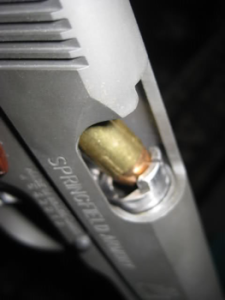 This malfunction actually interrupts the second half of the firing cycle, preparing the gun to shoot the next shot. There are many things that can cause this problem. The magazine could be damaged or dirty. The magazine spring may need to be replaced. The action of the gun may be dirty and need cleaning. The gun may not work well with the type of ammunition (hollow points tend to be more pointy than round nose bullets and often cause feed problems when hitting the barrel ramp.) The recoil spring may be faulty or weak. There are so many possible causes, how do you determine what the problem is? My advice is to clear the malfunction by removing the magazine and the half-chambered round. Reload and get back to firing. If it happens again, start eliminating some of the potential causes. If this ammo has always worked, it’s probably not that. Try a different magazine (and remember to mark the possible bad magazine with a piece of tape on the bottom.) If the gun’s dirty – clean it!
This malfunction actually interrupts the second half of the firing cycle, preparing the gun to shoot the next shot. There are many things that can cause this problem. The magazine could be damaged or dirty. The magazine spring may need to be replaced. The action of the gun may be dirty and need cleaning. The gun may not work well with the type of ammunition (hollow points tend to be more pointy than round nose bullets and often cause feed problems when hitting the barrel ramp.) The recoil spring may be faulty or weak. There are so many possible causes, how do you determine what the problem is? My advice is to clear the malfunction by removing the magazine and the half-chambered round. Reload and get back to firing. If it happens again, start eliminating some of the potential causes. If this ammo has always worked, it’s probably not that. Try a different magazine (and remember to mark the possible bad magazine with a piece of tape on the bottom.) If the gun’s dirty – clean it!
Firearm Type 2 Malfunction – Failure to Eject (Stovepipe)
This is the most well known malfunction. The fired case is not properly ejected from the gun and gets stuck in the action, normally sticking out the top of the slide like a stove pipe. Since the slide has not returned to its full forward position, the gun is not in battery and will not fire.
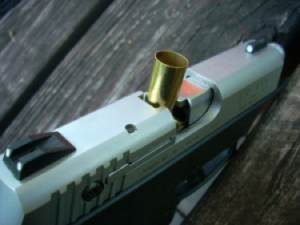 I’ve been shooting with some US Marines who cleared their stovepipes by swiping their palms across the top of the slide from muzzle to rear. It often pulls the shell out, but it tears up my gentle hands pretty good.
I’ve been shooting with some US Marines who cleared their stovepipes by swiping their palms across the top of the slide from muzzle to rear. It often pulls the shell out, but it tears up my gentle hands pretty good.
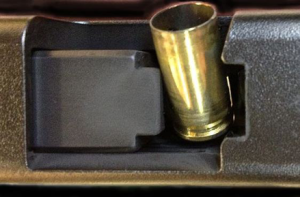 A better solution is to tap the magazine to ensure it is firmly seated, then rack the slide while turning the handgun so the ejection port is facing down. The stovepiped case will fall out and a round will be chambered.
A better solution is to tap the magazine to ensure it is firmly seated, then rack the slide while turning the handgun so the ejection port is facing down. The stovepiped case will fall out and a round will be chambered.
This malfunction is really the only one that YOU can actually cause. I’m not talking about failure to seat the magazine, but rather, failure to properly handle the firearm. If you don’t hold the handgun properly (especially a GLOCK), the inertia sending the slide to the rear may be absorbed by the movement of the gun rather than properly compressing the recoil spring. This is commonly called “limp-wristing.” So get a grip! Hold the firearm firmly so you control the muzzle flip and you will avoid the dreaded Failure to Eject malfunction.
Firearm Type 3 Malfunction – Failure to Extract (Double Feed)
This malfunction is a pain in the neck. There are not many shooters that can react quickly with immediate action to clear this malfunction because they fail to practice. This is really two malfunctions, one causing the second. A failure to extract causes the next round in the magazine to be fed into the head stamp of the previous round. To clear this malfunction properly, the slide must be locked to the rear, then the magazine may be removed. If you don’t lock the slide to the rear there is often too much pressure on the two rounds to allow the magazine to drop free easily.
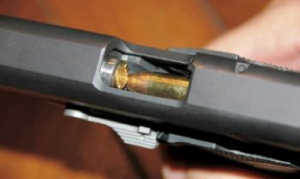 Whether you’re shooting in competition, self-defense or plinking, you must know how to keep your firearm safe. You must know the manual of arms for your firearm, and both immediate and remedial action in the event of a malfunction. If you feel underprepared, seek education from a certified instructor.
Whether you’re shooting in competition, self-defense or plinking, you must know how to keep your firearm safe. You must know the manual of arms for your firearm, and both immediate and remedial action in the event of a malfunction. If you feel underprepared, seek education from a certified instructor.
See you at the range!
JoeGLOCK
